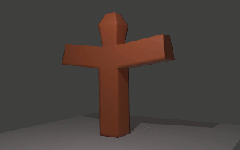Simulating actual airflow and pressure would require complicated fluid dynamics simulation - but you could simulate the effect using Soft Body physics.
Create you mesh and add Soft Body in the Physics properties.
Select the vertices that you want to tie to a fixed point (eg, the ground) and assign them to a new Vertex Group. This will be used to pin them in place so that the mesh is anchored.
It is then just a matter of adjusting the Soft Body properties to get the desired effect, simulating the lack of air pressure by reducing the Soft Body Edge Spings and applying the pressure/air flow by increasing the Edge Springs.

The Soft Body Goal pins vertices in place - set the Vertex Group to the group created to act as the 'anchor' and increate the Strengths and Stiffness to force them to stay in place (otherwise they'll be allowed to drift from their start points).
Decrease the 'Bending' Soft Body Edges setting to allow the body to collapse and increase it to "inflate". You may need to adjust the other settings to get the desired effect.
To prevent the mesh from collapsing too far, set the Edge and Face collision checkboxes and enable Soft Body Self Collision. You might want to change the Self Collision settings to prevent the mesh folding too far into itself and/or change the Soft Body Solver settings for a more accurate simulation if it's behaving erratically (eg, reduce the Error Limit).







